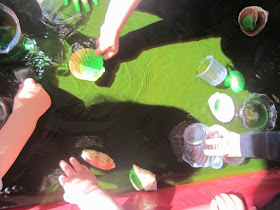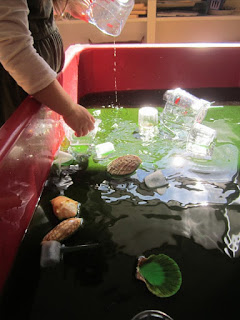I’ve always wondered why older preschoolers tend to ignore
the sensory table. Is sand and water play boring? Is it just that there are
more exciting things to do in the classroom? Toddlers and young 2’s and 3’s can’t
seem to get enough of sand and water play, scooping and pouring it
in and out of containers, watching it flow, mastering the
concepts of empty and full.
But in the older classrooms, the sand table, with its
scoops, measuring cups, and funnels, slowly gets left behind in favor of other
activities. As I watched the children play with the sand less and less as time
went on, this thought occurred to me: it’s not that the sand itself isn’t
interesting, it’s that the children have mastered the tasks we provided. They
learned how to scoop and dump. They figured out what it means for something to
be empty and full. What they needed was something new to figure out. They
needed to do more than the simple motion of manipulating sand from one
container to another. They needed materials that involved more complicated
problem solving – materials that said to them “hey, figure this out.”
My inspiration came from an amazing blog: Sand and Water Tables by Tom Bedard. Tom’s blog documents his development and use of
different sensory table “apparatus” in his preschool classroom. I was awed by
the complexity and limitless problem solving opportunities his materials
provided. I decided to start small – with two pegboards supported by wooden
dowels, creating a “two-story” platform for the sand table.
Interest in the area increased at once. The children had
experienced the process of simply pouring sand, but watching the process of
sand flowing through holes was something new. Could the sand be piled up and
the holes blocked? Would pushing the sand with hands or a brush make it flow
through faster? Was there a way to slow or increase the flow between the two
levels? A large group of children gathered around, experimenting, watching, and
testing as they poured, brushed, and blocked the sand as it flowed.
This was more than just sensory play and experiencing the
sensation of sand on hands. This was engineering, problem solving, and scientific
theorizing. This was an opportunity for children to pose questions and figure
out the answers for themselves. It was a chance to figure out how things work,
and to take their play, literally and figuratively, to the next level.














